Comparative Analysis: Job Costing and ABC in Manufacturing Context
VerifiedAdded on 2023/03/23
|14
|3127
|77
Case Study
AI Summary
This case study provides a comprehensive analysis of job costing and activity-based costing (ABC) methods, primarily focusing on a manufacturing company's production processes. It begins by introducing the importance of accurate pricing in manufacturing and highlights the limitations of traditional costing methods. The paper then delves into the specifics of job costing, including its application in scenarios where products or services are customized. It discusses the allocation of manufacturing overhead and potential difficulties in this process. The case study provides detailed calculations for work-in-progress inventory, finished goods inventory, and cost of production. It also addresses the treatment of over-applied or under-applied overheads, presenting two alternative accounting treatments. Finally, the paper explores how activity-based costing can overcome the deficiencies of traditional job costing by dividing production into diverse activities and allocating expenses based on the cost of those activities. The analysis emphasizes the importance of accurate cost allocation for effective pricing strategies.
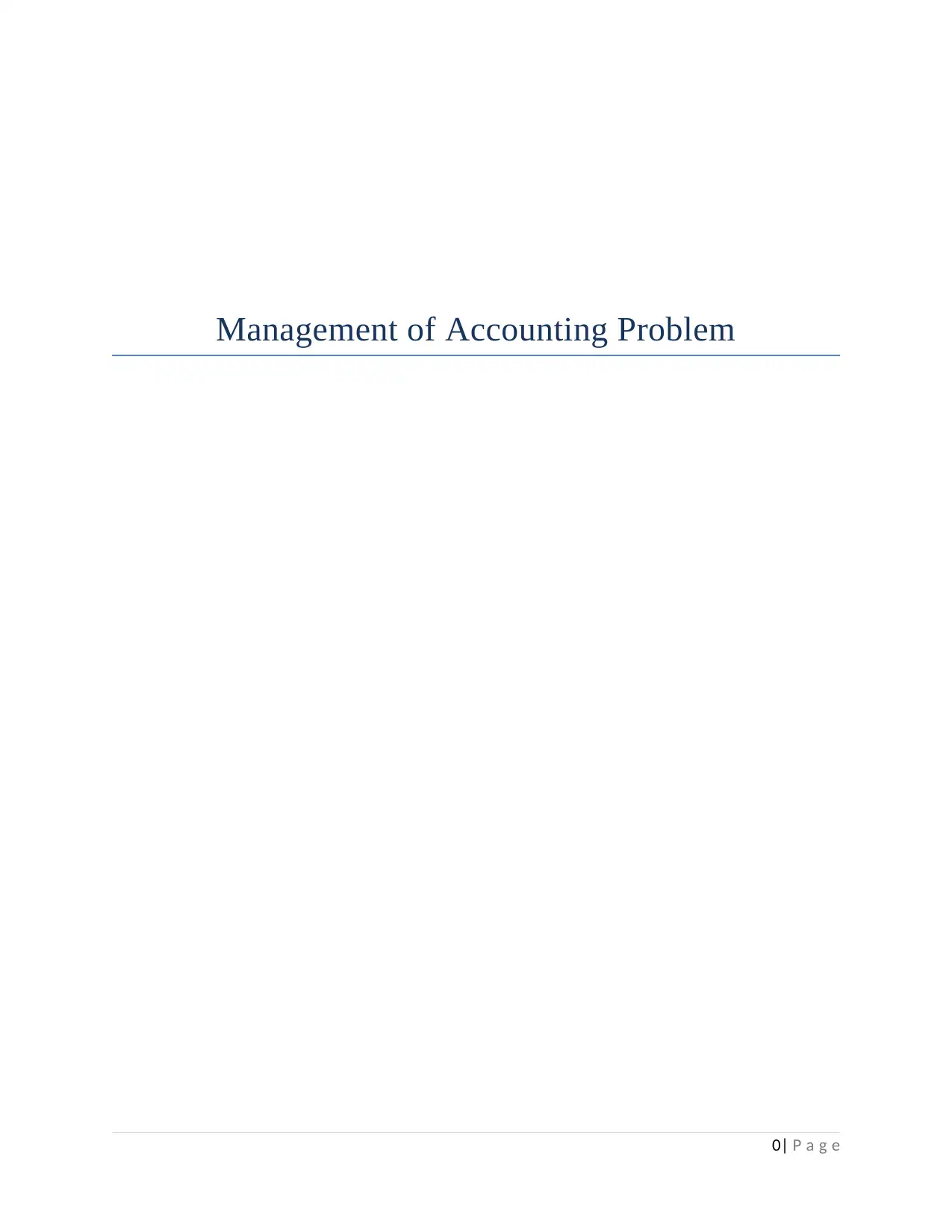
Management of Accounting Problem
0| P a g e
0| P a g e
Paraphrase This Document
Need a fresh take? Get an instant paraphrase of this document with our AI Paraphraser
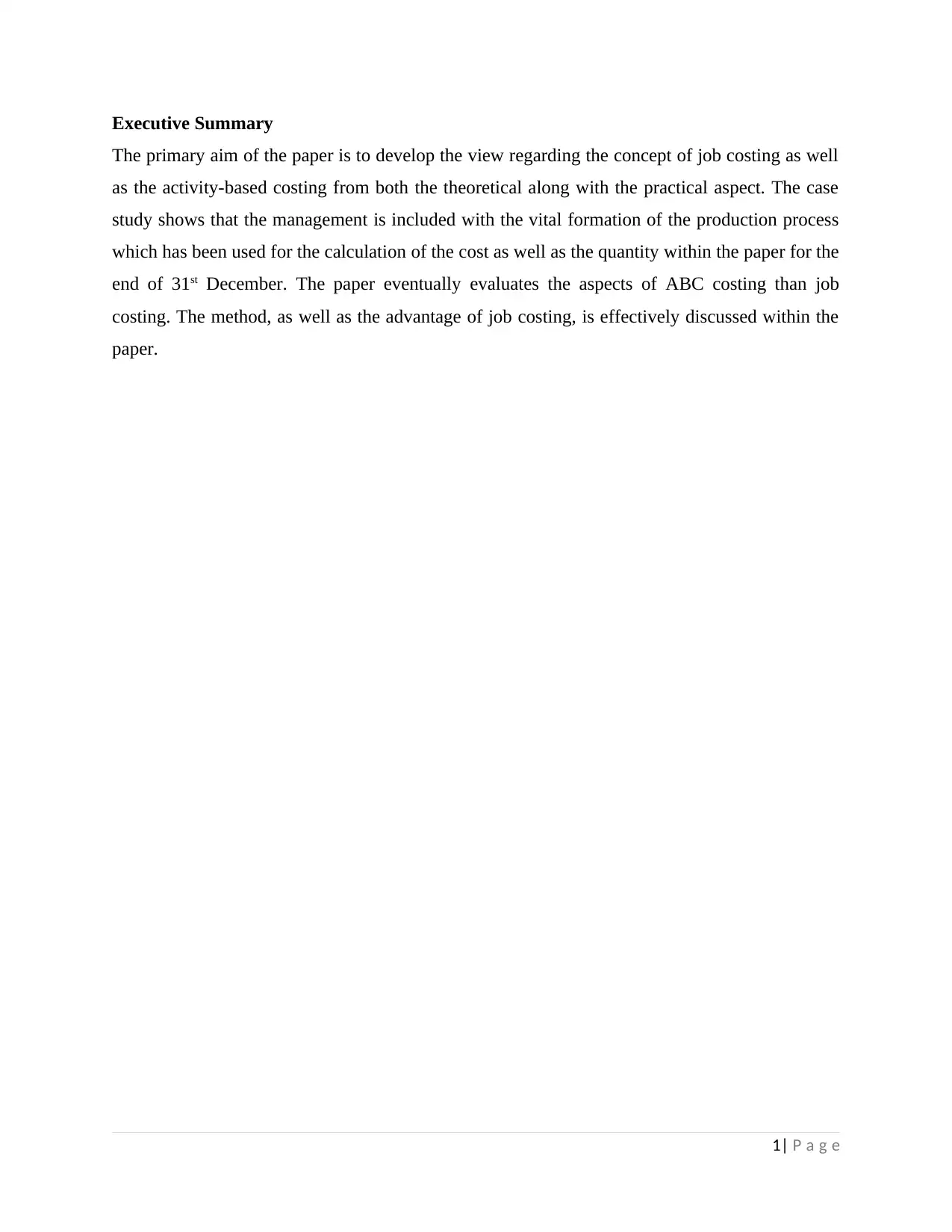
Executive Summary
The primary aim of the paper is to develop the view regarding the concept of job costing as well
as the activity-based costing from both the theoretical along with the practical aspect. The case
study shows that the management is included with the vital formation of the production process
which has been used for the calculation of the cost as well as the quantity within the paper for the
end of 31st December. The paper eventually evaluates the aspects of ABC costing than job
costing. The method, as well as the advantage of job costing, is effectively discussed within the
paper.
1| P a g e
The primary aim of the paper is to develop the view regarding the concept of job costing as well
as the activity-based costing from both the theoretical along with the practical aspect. The case
study shows that the management is included with the vital formation of the production process
which has been used for the calculation of the cost as well as the quantity within the paper for the
end of 31st December. The paper eventually evaluates the aspects of ABC costing than job
costing. The method, as well as the advantage of job costing, is effectively discussed within the
paper.
1| P a g e
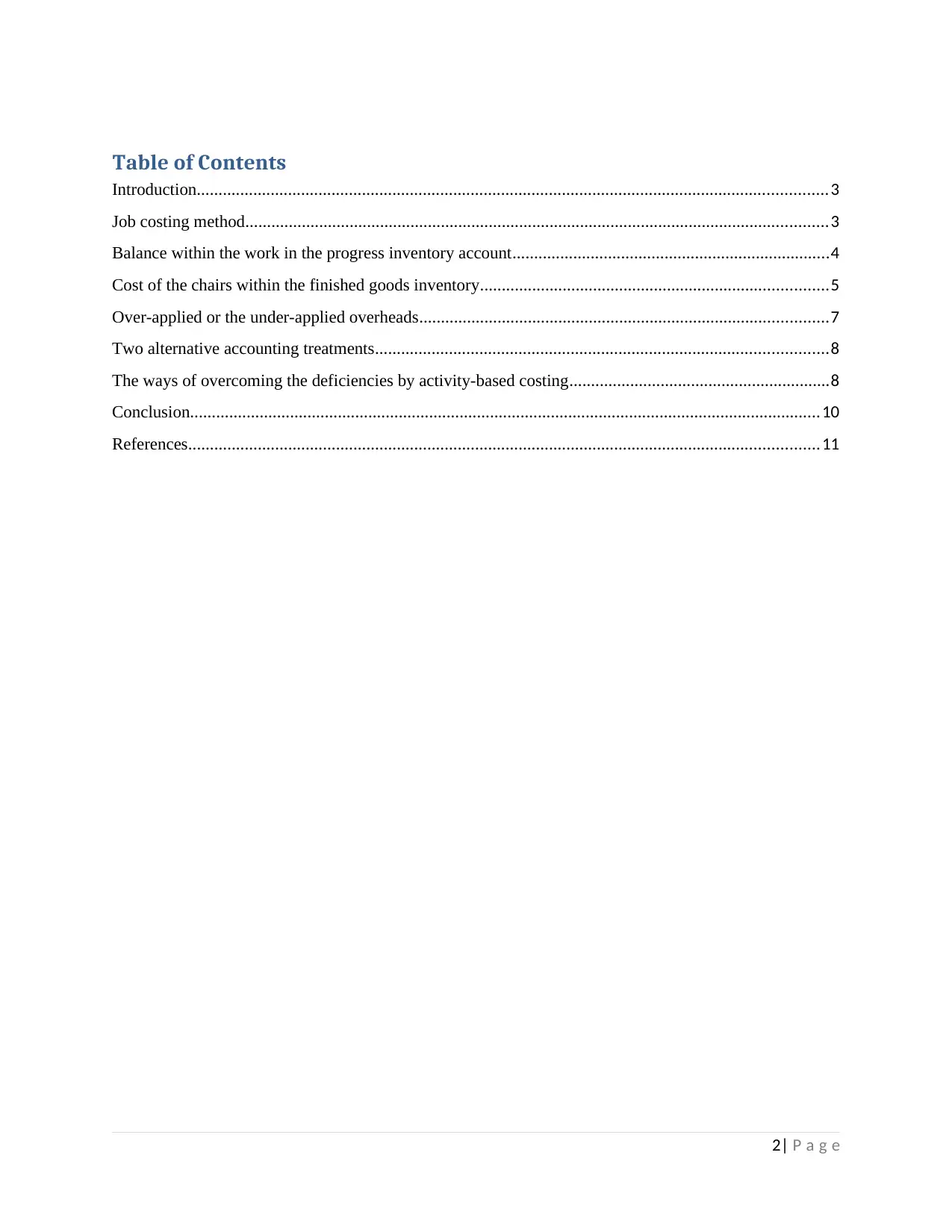
Table of Contents
Introduction.................................................................................................................................................3
Job costing method......................................................................................................................................3
Balance within the work in the progress inventory account.........................................................................4
Cost of the chairs within the finished goods inventory................................................................................5
Over-applied or the under-applied overheads..............................................................................................7
Two alternative accounting treatments........................................................................................................8
The ways of overcoming the deficiencies by activity-based costing............................................................8
Conclusion.................................................................................................................................................10
References.................................................................................................................................................11
2| P a g e
Introduction.................................................................................................................................................3
Job costing method......................................................................................................................................3
Balance within the work in the progress inventory account.........................................................................4
Cost of the chairs within the finished goods inventory................................................................................5
Over-applied or the under-applied overheads..............................................................................................7
Two alternative accounting treatments........................................................................................................8
The ways of overcoming the deficiencies by activity-based costing............................................................8
Conclusion.................................................................................................................................................10
References.................................................................................................................................................11
2| P a g e
⊘ This is a preview!⊘
Do you want full access?
Subscribe today to unlock all pages.

Trusted by 1+ million students worldwide
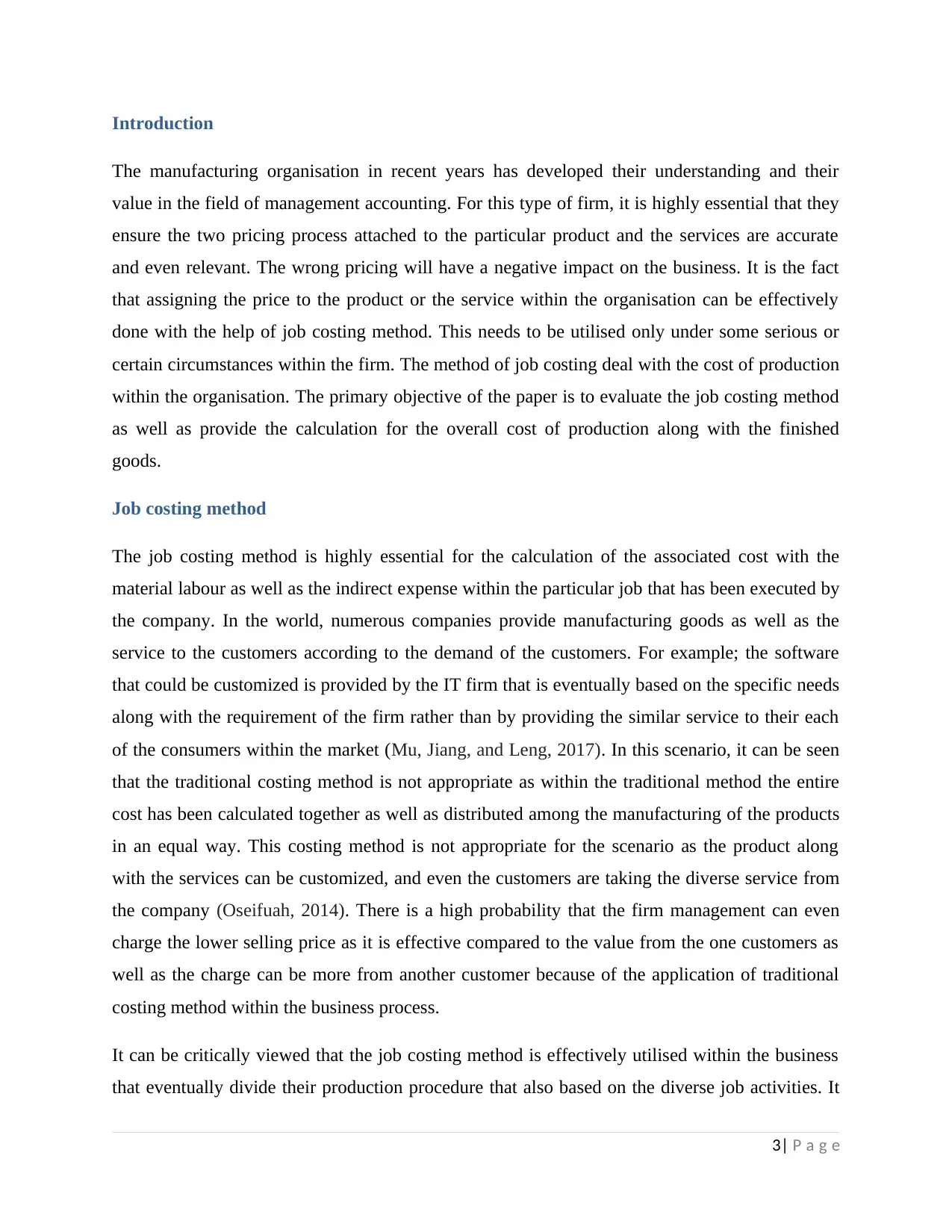
Introduction
The manufacturing organisation in recent years has developed their understanding and their
value in the field of management accounting. For this type of firm, it is highly essential that they
ensure the two pricing process attached to the particular product and the services are accurate
and even relevant. The wrong pricing will have a negative impact on the business. It is the fact
that assigning the price to the product or the service within the organisation can be effectively
done with the help of job costing method. This needs to be utilised only under some serious or
certain circumstances within the firm. The method of job costing deal with the cost of production
within the organisation. The primary objective of the paper is to evaluate the job costing method
as well as provide the calculation for the overall cost of production along with the finished
goods.
Job costing method
The job costing method is highly essential for the calculation of the associated cost with the
material labour as well as the indirect expense within the particular job that has been executed by
the company. In the world, numerous companies provide manufacturing goods as well as the
service to the customers according to the demand of the customers. For example; the software
that could be customized is provided by the IT firm that is eventually based on the specific needs
along with the requirement of the firm rather than by providing the similar service to their each
of the consumers within the market (Mu, Jiang, and Leng, 2017). In this scenario, it can be seen
that the traditional costing method is not appropriate as within the traditional method the entire
cost has been calculated together as well as distributed among the manufacturing of the products
in an equal way. This costing method is not appropriate for the scenario as the product along
with the services can be customized, and even the customers are taking the diverse service from
the company (Oseifuah, 2014). There is a high probability that the firm management can even
charge the lower selling price as it is effective compared to the value from the one customers as
well as the charge can be more from another customer because of the application of traditional
costing method within the business process.
It can be critically viewed that the job costing method is effectively utilised within the business
that eventually divide their production procedure that also based on the diverse job activities. It
3| P a g e
The manufacturing organisation in recent years has developed their understanding and their
value in the field of management accounting. For this type of firm, it is highly essential that they
ensure the two pricing process attached to the particular product and the services are accurate
and even relevant. The wrong pricing will have a negative impact on the business. It is the fact
that assigning the price to the product or the service within the organisation can be effectively
done with the help of job costing method. This needs to be utilised only under some serious or
certain circumstances within the firm. The method of job costing deal with the cost of production
within the organisation. The primary objective of the paper is to evaluate the job costing method
as well as provide the calculation for the overall cost of production along with the finished
goods.
Job costing method
The job costing method is highly essential for the calculation of the associated cost with the
material labour as well as the indirect expense within the particular job that has been executed by
the company. In the world, numerous companies provide manufacturing goods as well as the
service to the customers according to the demand of the customers. For example; the software
that could be customized is provided by the IT firm that is eventually based on the specific needs
along with the requirement of the firm rather than by providing the similar service to their each
of the consumers within the market (Mu, Jiang, and Leng, 2017). In this scenario, it can be seen
that the traditional costing method is not appropriate as within the traditional method the entire
cost has been calculated together as well as distributed among the manufacturing of the products
in an equal way. This costing method is not appropriate for the scenario as the product along
with the services can be customized, and even the customers are taking the diverse service from
the company (Oseifuah, 2014). There is a high probability that the firm management can even
charge the lower selling price as it is effective compared to the value from the one customers as
well as the charge can be more from another customer because of the application of traditional
costing method within the business process.
It can be critically viewed that the job costing method is effectively utilised within the business
that eventually divide their production procedure that also based on the diverse job activities. It
3| P a g e
Paraphrase This Document
Need a fresh take? Get an instant paraphrase of this document with our AI Paraphraser
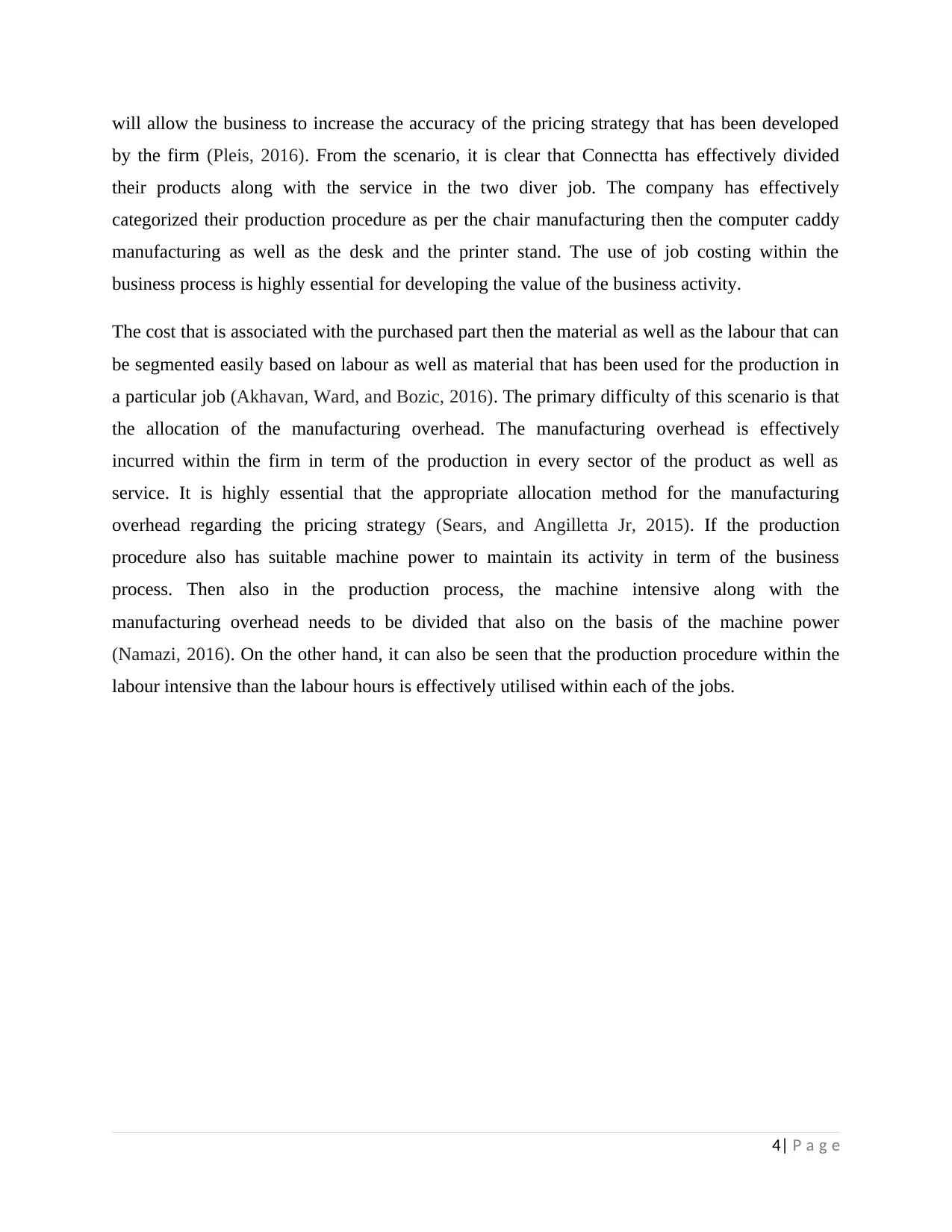
will allow the business to increase the accuracy of the pricing strategy that has been developed
by the firm (Pleis, 2016). From the scenario, it is clear that Connectta has effectively divided
their products along with the service in the two diver job. The company has effectively
categorized their production procedure as per the chair manufacturing then the computer caddy
manufacturing as well as the desk and the printer stand. The use of job costing within the
business process is highly essential for developing the value of the business activity.
The cost that is associated with the purchased part then the material as well as the labour that can
be segmented easily based on labour as well as material that has been used for the production in
a particular job (Akhavan, Ward, and Bozic, 2016). The primary difficulty of this scenario is that
the allocation of the manufacturing overhead. The manufacturing overhead is effectively
incurred within the firm in term of the production in every sector of the product as well as
service. It is highly essential that the appropriate allocation method for the manufacturing
overhead regarding the pricing strategy (Sears, and Angilletta Jr, 2015). If the production
procedure also has suitable machine power to maintain its activity in term of the business
process. Then also in the production process, the machine intensive along with the
manufacturing overhead needs to be divided that also on the basis of the machine power
(Namazi, 2016). On the other hand, it can also be seen that the production procedure within the
labour intensive than the labour hours is effectively utilised within each of the jobs.
4| P a g e
by the firm (Pleis, 2016). From the scenario, it is clear that Connectta has effectively divided
their products along with the service in the two diver job. The company has effectively
categorized their production procedure as per the chair manufacturing then the computer caddy
manufacturing as well as the desk and the printer stand. The use of job costing within the
business process is highly essential for developing the value of the business activity.
The cost that is associated with the purchased part then the material as well as the labour that can
be segmented easily based on labour as well as material that has been used for the production in
a particular job (Akhavan, Ward, and Bozic, 2016). The primary difficulty of this scenario is that
the allocation of the manufacturing overhead. The manufacturing overhead is effectively
incurred within the firm in term of the production in every sector of the product as well as
service. It is highly essential that the appropriate allocation method for the manufacturing
overhead regarding the pricing strategy (Sears, and Angilletta Jr, 2015). If the production
procedure also has suitable machine power to maintain its activity in term of the business
process. Then also in the production process, the machine intensive along with the
manufacturing overhead needs to be divided that also on the basis of the machine power
(Namazi, 2016). On the other hand, it can also be seen that the production procedure within the
labour intensive than the labour hours is effectively utilised within each of the jobs.
4| P a g e
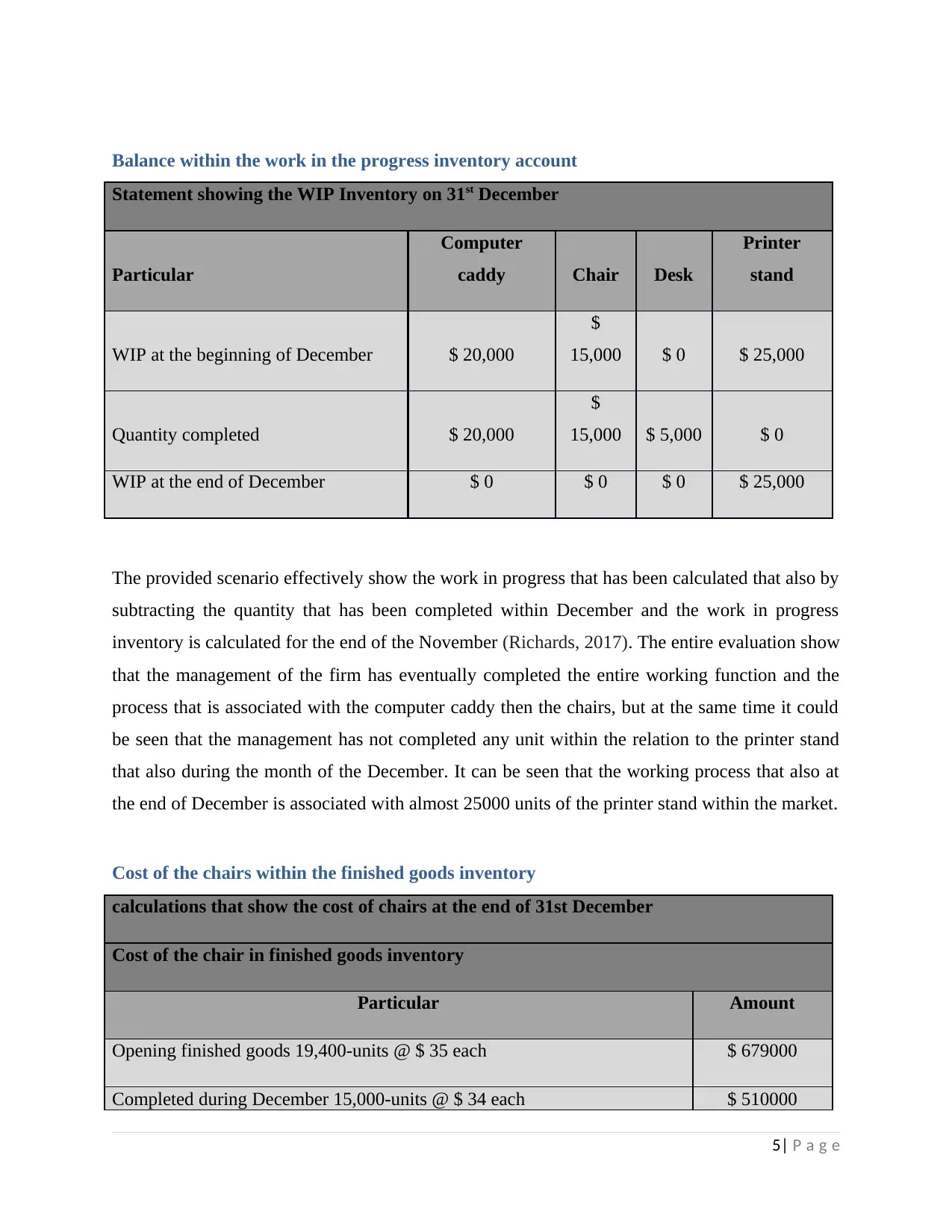
Balance within the work in the progress inventory account
Statement showing the WIP Inventory on 31st December
Particular
Computer
caddy Chair Desk
Printer
stand
WIP at the beginning of December $ 20,000
$
15,000 $ 0 $ 25,000
Quantity completed $ 20,000
$
15,000 $ 5,000 $ 0
WIP at the end of December $ 0 $ 0 $ 0 $ 25,000
The provided scenario effectively show the work in progress that has been calculated that also by
subtracting the quantity that has been completed within December and the work in progress
inventory is calculated for the end of the November (Richards, 2017). The entire evaluation show
that the management of the firm has eventually completed the entire working function and the
process that is associated with the computer caddy then the chairs, but at the same time it could
be seen that the management has not completed any unit within the relation to the printer stand
that also during the month of the December. It can be seen that the working process that also at
the end of December is associated with almost 25000 units of the printer stand within the market.
Cost of the chairs within the finished goods inventory
calculations that show the cost of chairs at the end of 31st December
Cost of the chair in finished goods inventory
Particular Amount
Opening finished goods 19,400-units @ $ 35 each $ 679000
Completed during December 15,000-units @ $ 34 each $ 510000
5| P a g e
Statement showing the WIP Inventory on 31st December
Particular
Computer
caddy Chair Desk
Printer
stand
WIP at the beginning of December $ 20,000
$
15,000 $ 0 $ 25,000
Quantity completed $ 20,000
$
15,000 $ 5,000 $ 0
WIP at the end of December $ 0 $ 0 $ 0 $ 25,000
The provided scenario effectively show the work in progress that has been calculated that also by
subtracting the quantity that has been completed within December and the work in progress
inventory is calculated for the end of the November (Richards, 2017). The entire evaluation show
that the management of the firm has eventually completed the entire working function and the
process that is associated with the computer caddy then the chairs, but at the same time it could
be seen that the management has not completed any unit within the relation to the printer stand
that also during the month of the December. It can be seen that the working process that also at
the end of December is associated with almost 25000 units of the printer stand within the market.
Cost of the chairs within the finished goods inventory
calculations that show the cost of chairs at the end of 31st December
Cost of the chair in finished goods inventory
Particular Amount
Opening finished goods 19,400-units @ $ 35 each $ 679000
Completed during December 15,000-units @ $ 34 each $ 510000
5| P a g e
⊘ This is a preview!⊘
Do you want full access?
Subscribe today to unlock all pages.

Trusted by 1+ million students worldwide
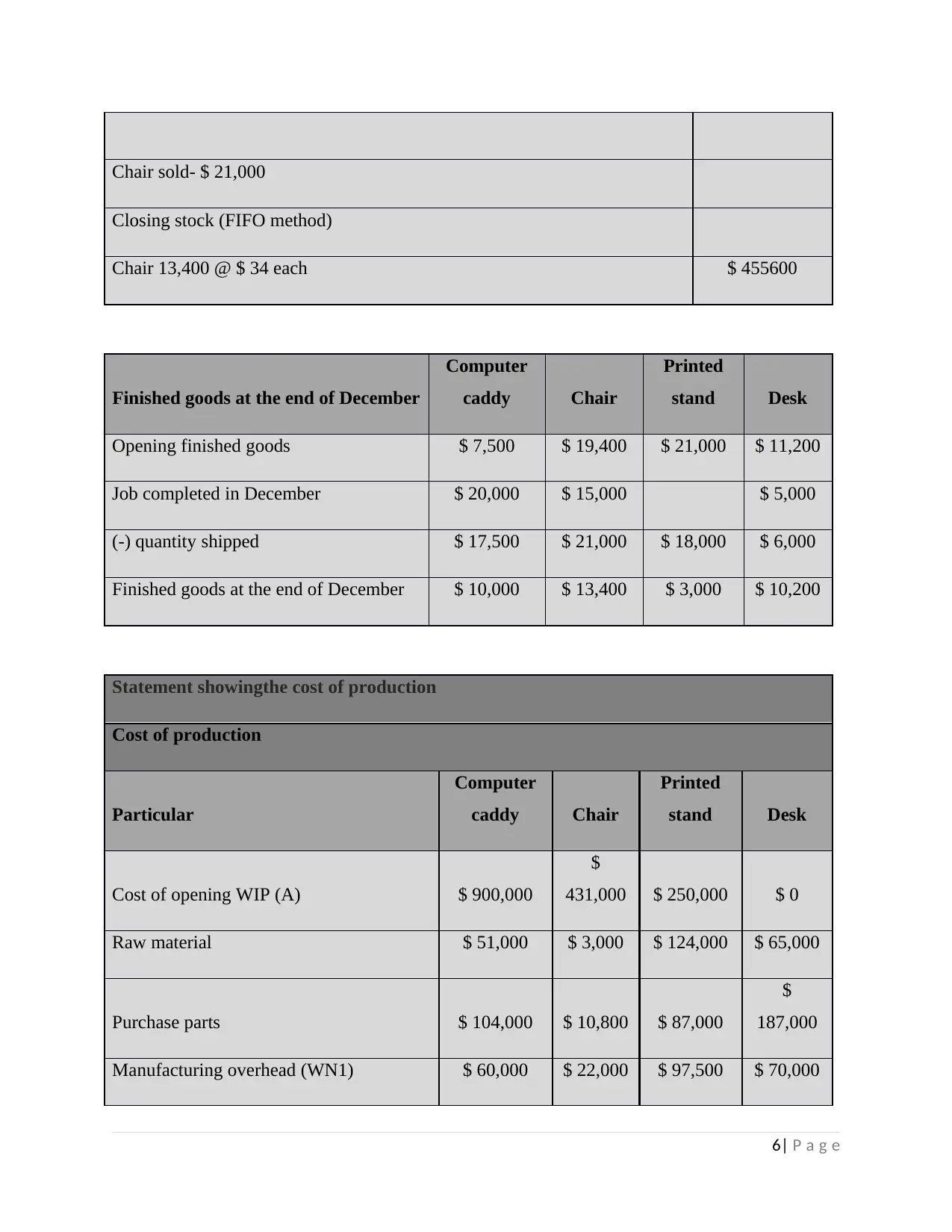
Chair sold- $ 21,000
Closing stock (FIFO method)
Chair 13,400 @ $ 34 each $ 455600
Finished goods at the end of December
Computer
caddy Chair
Printed
stand Desk
Opening finished goods $ 7,500 $ 19,400 $ 21,000 $ 11,200
Job completed in December $ 20,000 $ 15,000 $ 5,000
(-) quantity shipped $ 17,500 $ 21,000 $ 18,000 $ 6,000
Finished goods at the end of December $ 10,000 $ 13,400 $ 3,000 $ 10,200
Statement showingthe cost of production
Cost of production
Particular
Computer
caddy Chair
Printed
stand Desk
Cost of opening WIP (A) $ 900,000
$
431,000 $ 250,000 $ 0
Raw material $ 51,000 $ 3,000 $ 124,000 $ 65,000
Purchase parts $ 104,000 $ 10,800 $ 87,000
$
187,000
Manufacturing overhead (WN1) $ 60,000 $ 22,000 $ 97,500 $ 70,000
6| P a g e
Closing stock (FIFO method)
Chair 13,400 @ $ 34 each $ 455600
Finished goods at the end of December
Computer
caddy Chair
Printed
stand Desk
Opening finished goods $ 7,500 $ 19,400 $ 21,000 $ 11,200
Job completed in December $ 20,000 $ 15,000 $ 5,000
(-) quantity shipped $ 17,500 $ 21,000 $ 18,000 $ 6,000
Finished goods at the end of December $ 10,000 $ 13,400 $ 3,000 $ 10,200
Statement showingthe cost of production
Cost of production
Particular
Computer
caddy Chair
Printed
stand Desk
Cost of opening WIP (A) $ 900,000
$
431,000 $ 250,000 $ 0
Raw material $ 51,000 $ 3,000 $ 124,000 $ 65,000
Purchase parts $ 104,000 $ 10,800 $ 87,000
$
187,000
Manufacturing overhead (WN1) $ 60,000 $ 22,000 $ 97,500 $ 70,000
6| P a g e
Paraphrase This Document
Need a fresh take? Get an instant paraphrase of this document with our AI Paraphraser
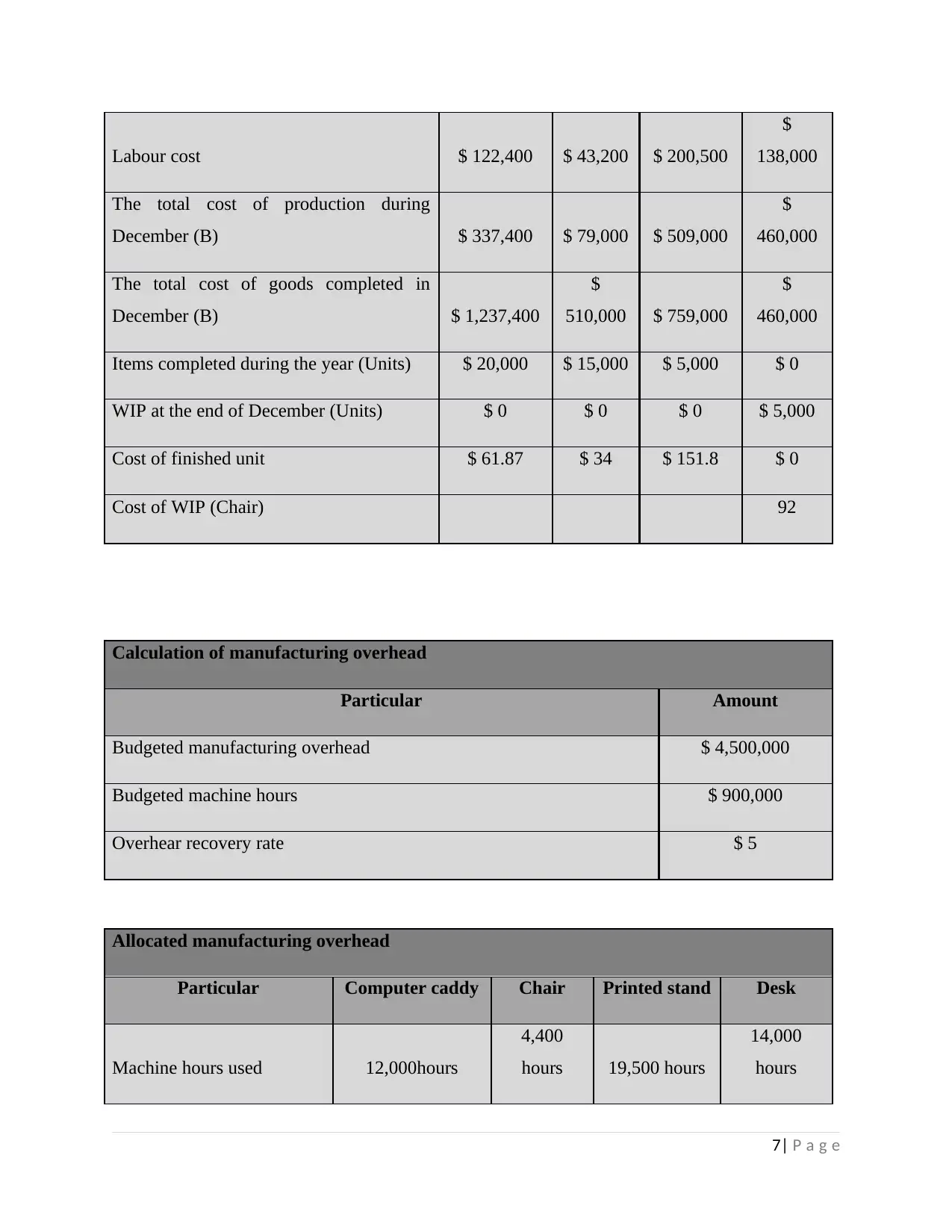
Labour cost $ 122,400 $ 43,200 $ 200,500
$
138,000
The total cost of production during
December (B) $ 337,400 $ 79,000 $ 509,000
$
460,000
The total cost of goods completed in
December (B) $ 1,237,400
$
510,000 $ 759,000
$
460,000
Items completed during the year (Units) $ 20,000 $ 15,000 $ 5,000 $ 0
WIP at the end of December (Units) $ 0 $ 0 $ 0 $ 5,000
Cost of finished unit $ 61.87 $ 34 $ 151.8 $ 0
Cost of WIP (Chair) 92
Calculation of manufacturing overhead
Particular Amount
Budgeted manufacturing overhead $ 4,500,000
Budgeted machine hours $ 900,000
Overhear recovery rate $ 5
Allocated manufacturing overhead
Particular Computer caddy Chair Printed stand Desk
Machine hours used 12,000hours
4,400
hours 19,500 hours
14,000
hours
7| P a g e
$
138,000
The total cost of production during
December (B) $ 337,400 $ 79,000 $ 509,000
$
460,000
The total cost of goods completed in
December (B) $ 1,237,400
$
510,000 $ 759,000
$
460,000
Items completed during the year (Units) $ 20,000 $ 15,000 $ 5,000 $ 0
WIP at the end of December (Units) $ 0 $ 0 $ 0 $ 5,000
Cost of finished unit $ 61.87 $ 34 $ 151.8 $ 0
Cost of WIP (Chair) 92
Calculation of manufacturing overhead
Particular Amount
Budgeted manufacturing overhead $ 4,500,000
Budgeted machine hours $ 900,000
Overhear recovery rate $ 5
Allocated manufacturing overhead
Particular Computer caddy Chair Printed stand Desk
Machine hours used 12,000hours
4,400
hours 19,500 hours
14,000
hours
7| P a g e
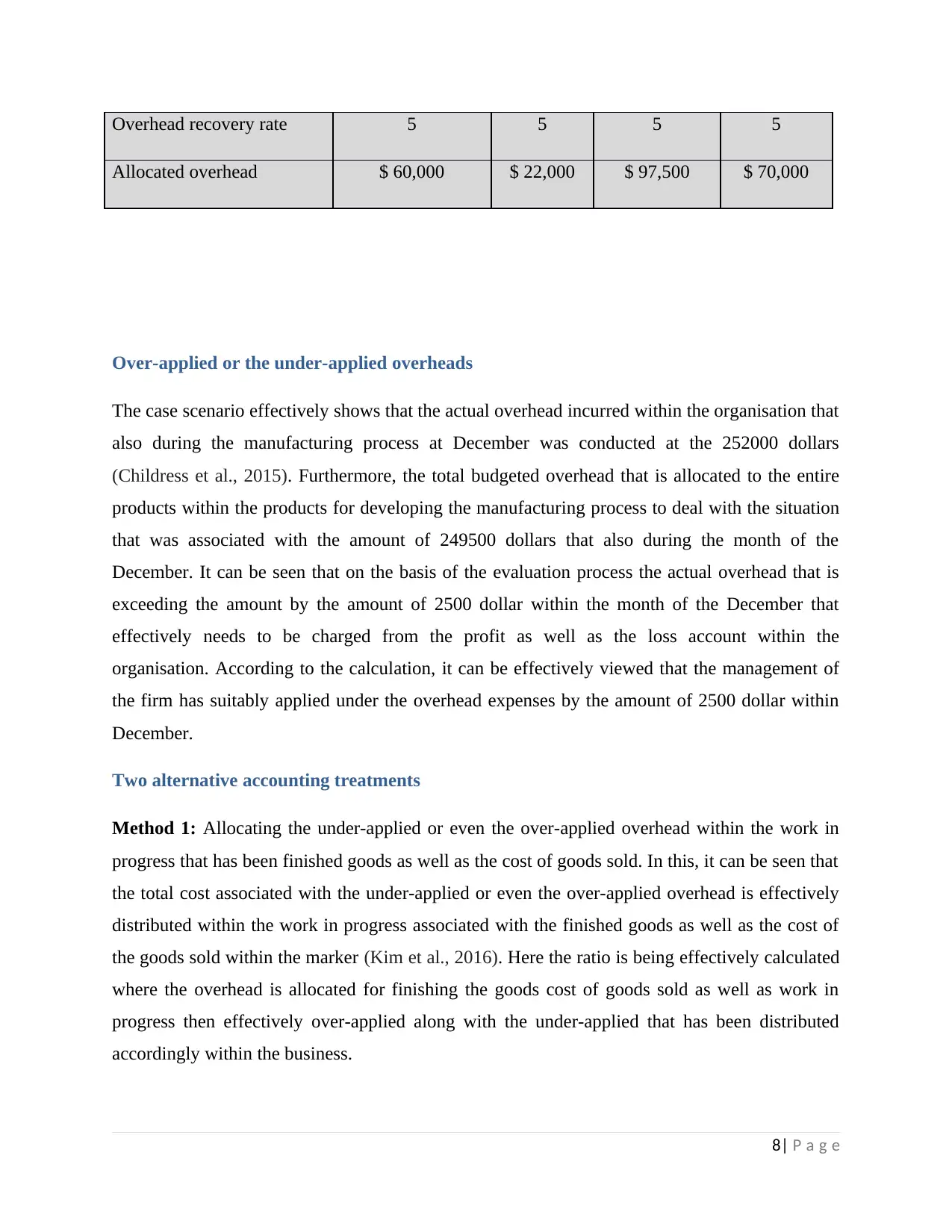
Overhead recovery rate 5 5 5 5
Allocated overhead $ 60,000 $ 22,000 $ 97,500 $ 70,000
Over-applied or the under-applied overheads
The case scenario effectively shows that the actual overhead incurred within the organisation that
also during the manufacturing process at December was conducted at the 252000 dollars
(Childress et al., 2015). Furthermore, the total budgeted overhead that is allocated to the entire
products within the products for developing the manufacturing process to deal with the situation
that was associated with the amount of 249500 dollars that also during the month of the
December. It can be seen that on the basis of the evaluation process the actual overhead that is
exceeding the amount by the amount of 2500 dollar within the month of the December that
effectively needs to be charged from the profit as well as the loss account within the
organisation. According to the calculation, it can be effectively viewed that the management of
the firm has suitably applied under the overhead expenses by the amount of 2500 dollar within
December.
Two alternative accounting treatments
Method 1: Allocating the under-applied or even the over-applied overhead within the work in
progress that has been finished goods as well as the cost of goods sold. In this, it can be seen that
the total cost associated with the under-applied or even the over-applied overhead is effectively
distributed within the work in progress associated with the finished goods as well as the cost of
the goods sold within the marker (Kim et al., 2016). Here the ratio is being effectively calculated
where the overhead is allocated for finishing the goods cost of goods sold as well as work in
progress then effectively over-applied along with the under-applied that has been distributed
accordingly within the business.
8| P a g e
Allocated overhead $ 60,000 $ 22,000 $ 97,500 $ 70,000
Over-applied or the under-applied overheads
The case scenario effectively shows that the actual overhead incurred within the organisation that
also during the manufacturing process at December was conducted at the 252000 dollars
(Childress et al., 2015). Furthermore, the total budgeted overhead that is allocated to the entire
products within the products for developing the manufacturing process to deal with the situation
that was associated with the amount of 249500 dollars that also during the month of the
December. It can be seen that on the basis of the evaluation process the actual overhead that is
exceeding the amount by the amount of 2500 dollar within the month of the December that
effectively needs to be charged from the profit as well as the loss account within the
organisation. According to the calculation, it can be effectively viewed that the management of
the firm has suitably applied under the overhead expenses by the amount of 2500 dollar within
December.
Two alternative accounting treatments
Method 1: Allocating the under-applied or even the over-applied overhead within the work in
progress that has been finished goods as well as the cost of goods sold. In this, it can be seen that
the total cost associated with the under-applied or even the over-applied overhead is effectively
distributed within the work in progress associated with the finished goods as well as the cost of
the goods sold within the marker (Kim et al., 2016). Here the ratio is being effectively calculated
where the overhead is allocated for finishing the goods cost of goods sold as well as work in
progress then effectively over-applied along with the under-applied that has been distributed
accordingly within the business.
8| P a g e
⊘ This is a preview!⊘
Do you want full access?
Subscribe today to unlock all pages.

Trusted by 1+ million students worldwide
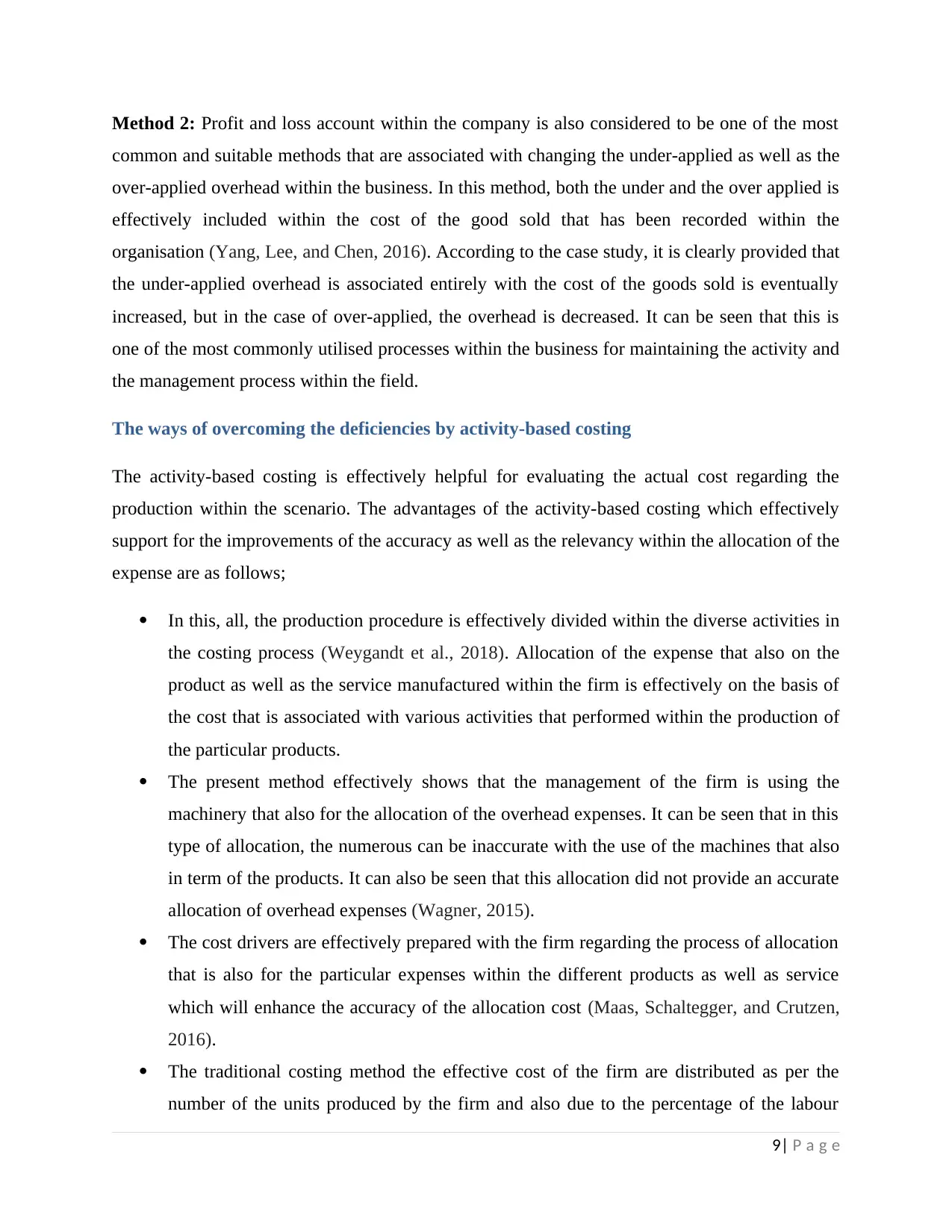
Method 2: Profit and loss account within the company is also considered to be one of the most
common and suitable methods that are associated with changing the under-applied as well as the
over-applied overhead within the business. In this method, both the under and the over applied is
effectively included within the cost of the good sold that has been recorded within the
organisation (Yang, Lee, and Chen, 2016). According to the case study, it is clearly provided that
the under-applied overhead is associated entirely with the cost of the goods sold is eventually
increased, but in the case of over-applied, the overhead is decreased. It can be seen that this is
one of the most commonly utilised processes within the business for maintaining the activity and
the management process within the field.
The ways of overcoming the deficiencies by activity-based costing
The activity-based costing is effectively helpful for evaluating the actual cost regarding the
production within the scenario. The advantages of the activity-based costing which effectively
support for the improvements of the accuracy as well as the relevancy within the allocation of the
expense are as follows;
In this, all, the production procedure is effectively divided within the diverse activities in
the costing process (Weygandt et al., 2018). Allocation of the expense that also on the
product as well as the service manufactured within the firm is effectively on the basis of
the cost that is associated with various activities that performed within the production of
the particular products.
The present method effectively shows that the management of the firm is using the
machinery that also for the allocation of the overhead expenses. It can be seen that in this
type of allocation, the numerous can be inaccurate with the use of the machines that also
in term of the products. It can also be seen that this allocation did not provide an accurate
allocation of overhead expenses (Wagner, 2015).
The cost drivers are effectively prepared with the firm regarding the process of allocation
that is also for the particular expenses within the different products as well as service
which will enhance the accuracy of the allocation cost (Maas, Schaltegger, and Crutzen,
2016).
The traditional costing method the effective cost of the firm are distributed as per the
number of the units produced by the firm and also due to the percentage of the labour
9| P a g e
common and suitable methods that are associated with changing the under-applied as well as the
over-applied overhead within the business. In this method, both the under and the over applied is
effectively included within the cost of the good sold that has been recorded within the
organisation (Yang, Lee, and Chen, 2016). According to the case study, it is clearly provided that
the under-applied overhead is associated entirely with the cost of the goods sold is eventually
increased, but in the case of over-applied, the overhead is decreased. It can be seen that this is
one of the most commonly utilised processes within the business for maintaining the activity and
the management process within the field.
The ways of overcoming the deficiencies by activity-based costing
The activity-based costing is effectively helpful for evaluating the actual cost regarding the
production within the scenario. The advantages of the activity-based costing which effectively
support for the improvements of the accuracy as well as the relevancy within the allocation of the
expense are as follows;
In this, all, the production procedure is effectively divided within the diverse activities in
the costing process (Weygandt et al., 2018). Allocation of the expense that also on the
product as well as the service manufactured within the firm is effectively on the basis of
the cost that is associated with various activities that performed within the production of
the particular products.
The present method effectively shows that the management of the firm is using the
machinery that also for the allocation of the overhead expenses. It can be seen that in this
type of allocation, the numerous can be inaccurate with the use of the machines that also
in term of the products. It can also be seen that this allocation did not provide an accurate
allocation of overhead expenses (Wagner, 2015).
The cost drivers are effectively prepared with the firm regarding the process of allocation
that is also for the particular expenses within the different products as well as service
which will enhance the accuracy of the allocation cost (Maas, Schaltegger, and Crutzen,
2016).
The traditional costing method the effective cost of the firm are distributed as per the
number of the units produced by the firm and also due to the percentage of the labour
9| P a g e
Paraphrase This Document
Need a fresh take? Get an instant paraphrase of this document with our AI Paraphraser
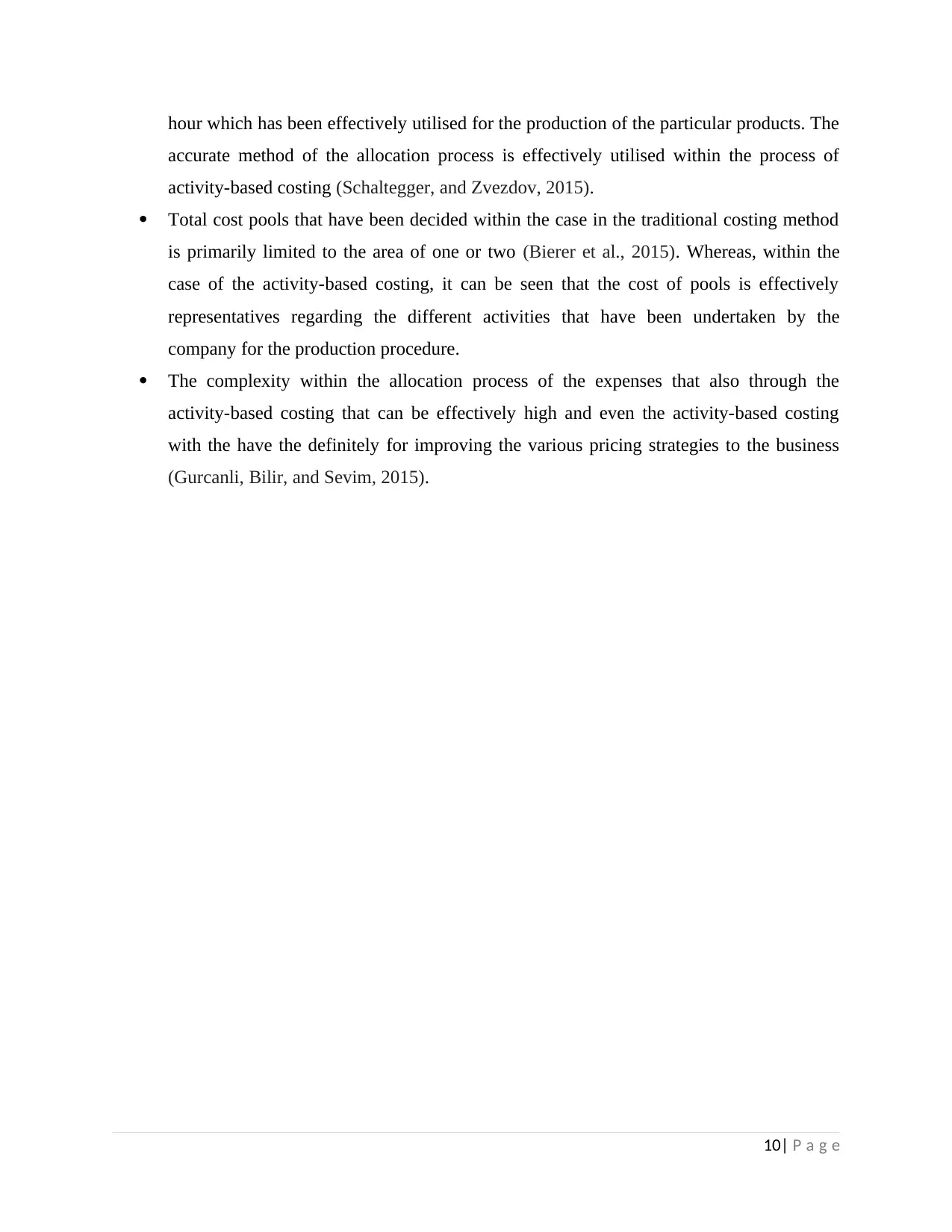
hour which has been effectively utilised for the production of the particular products. The
accurate method of the allocation process is effectively utilised within the process of
activity-based costing (Schaltegger, and Zvezdov, 2015).
Total cost pools that have been decided within the case in the traditional costing method
is primarily limited to the area of one or two (Bierer et al., 2015). Whereas, within the
case of the activity-based costing, it can be seen that the cost of pools is effectively
representatives regarding the different activities that have been undertaken by the
company for the production procedure.
The complexity within the allocation process of the expenses that also through the
activity-based costing that can be effectively high and even the activity-based costing
with the have the definitely for improving the various pricing strategies to the business
(Gurcanli, Bilir, and Sevim, 2015).
10| P a g e
accurate method of the allocation process is effectively utilised within the process of
activity-based costing (Schaltegger, and Zvezdov, 2015).
Total cost pools that have been decided within the case in the traditional costing method
is primarily limited to the area of one or two (Bierer et al., 2015). Whereas, within the
case of the activity-based costing, it can be seen that the cost of pools is effectively
representatives regarding the different activities that have been undertaken by the
company for the production procedure.
The complexity within the allocation process of the expenses that also through the
activity-based costing that can be effectively high and even the activity-based costing
with the have the definitely for improving the various pricing strategies to the business
(Gurcanli, Bilir, and Sevim, 2015).
10| P a g e
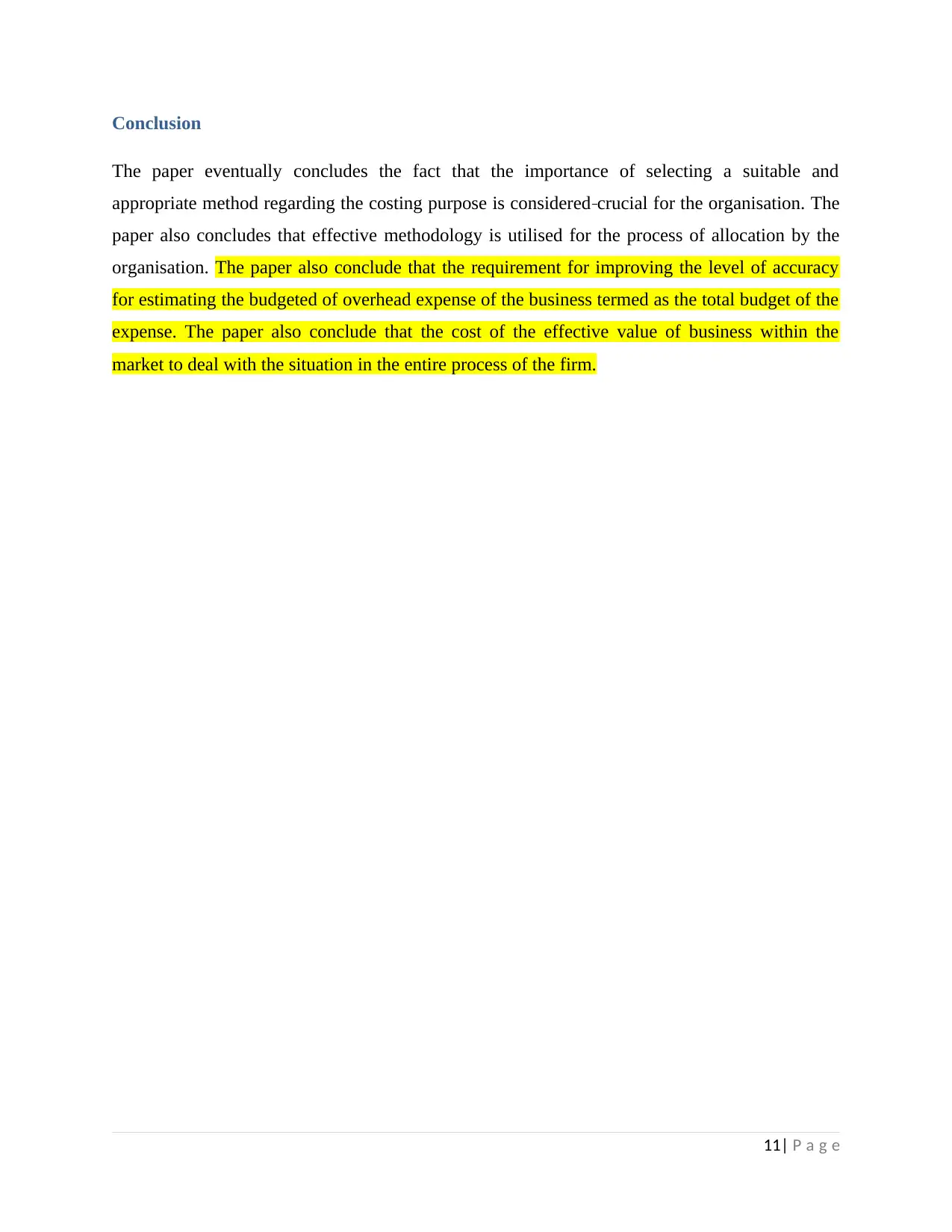
Conclusion
The paper eventually concludes the fact that the importance of selecting a suitable and
appropriate method regarding the costing purpose is considered crucial for the organisation. The
paper also concludes that effective methodology is utilised for the process of allocation by the
organisation. The paper also conclude that the requirement for improving the level of accuracy
for estimating the budgeted of overhead expense of the business termed as the total budget of the
expense. The paper also conclude that the cost of the effective value of business within the
market to deal with the situation in the entire process of the firm.
11| P a g e
The paper eventually concludes the fact that the importance of selecting a suitable and
appropriate method regarding the costing purpose is considered crucial for the organisation. The
paper also concludes that effective methodology is utilised for the process of allocation by the
organisation. The paper also conclude that the requirement for improving the level of accuracy
for estimating the budgeted of overhead expense of the business termed as the total budget of the
expense. The paper also conclude that the cost of the effective value of business within the
market to deal with the situation in the entire process of the firm.
11| P a g e
⊘ This is a preview!⊘
Do you want full access?
Subscribe today to unlock all pages.

Trusted by 1+ million students worldwide
1 out of 14
Related Documents
Your All-in-One AI-Powered Toolkit for Academic Success.
+13062052269
info@desklib.com
Available 24*7 on WhatsApp / Email
![[object Object]](/_next/static/media/star-bottom.7253800d.svg)
Unlock your academic potential
Copyright © 2020–2025 A2Z Services. All Rights Reserved. Developed and managed by ZUCOL.





